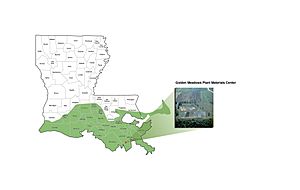Louisiana Native Plant Nurseries facts for kids
A Louisiana native plant nursery is a special place that grows only plants that naturally belong in Louisiana. These nurseries help bring back and increase the different kinds of native plants in the state. In Louisiana, these plants are super important for big projects that fix and protect wetlands and coastal areas. Nurseries are also great for studying plants in a controlled way, which helps scientists find better types of plants for restoration.
Contents
Why Native Plants Matter
A plant nursery is usually a farm where many different kinds of plants are grown for various reasons. Most nurseries grow both plants that are native to an area and plants from other places, often for gardens and city landscapes.
Louisiana native plant nurseries not only provide plants for big restoration projects but also offer plants for your home garden. A garden filled with native plants is often much easier to take care of. This is because native plants have grown with their environment (like the soil and weather) for a long time. They are used to the natural resources available, so they usually need less extra water, nutrients, or bug sprays. Plants that are not native to Louisiana might need a lot more care and resources to grow well.
Sadly, native plants, which are a key part of nature's web of life, are disappearing quickly. Using more native plants in your yard can really help the environment. Healthy natural areas help keep our water and air clean. Louisiana native plant nurseries encourage gardeners to use native plants to help local nature thrive. The Louisiana Native Plant Society is a good place to find a nursery near you or to learn more about Louisiana's native plants.
Protecting Louisiana's Wetlands
Louisiana's wetlands, which cover about 3 million acres, are shrinking by about 75 square kilometers every year. Stopping this loss is very hard and expensive. To try and slow down this problem, experts in Louisiana use different methods to fix damaged wetland areas.
Studies done in greenhouses at native plant nurseries help figure out the best ways to restore coastal wetlands. These studies look at how different native wetland plants and even different types of the same plant (called clones) grow. This information helps experts choose the right plants for specific restoration sites, matching the plants to the conditions of the area.
Plant Materials Program: Helping Nature
What the Program Does
The Plant Materials Program works to create and share new plant science ideas to help protect natural resources across the country. Its main goal is to find plant-based solutions for conservation problems. Plant Materials Centers (PMCs) all over the nation have developed over 600 types of conservation plants, including grasses, flowers, shrubs, and trees. Finding these unique plants that have evolved to meet specific conservation needs is a big focus of the program. These plants help protect millions of acres of land.
Golden Meadows Plant Materials Center
The Golden Meadows Plant Materials Center (LAPMC) is located in Galliano, Louisiana. It was started in 1989 by the Natural Resource Conservation Service (NRCS). The LAPMC develops plants and methods to help stop the loss of coastal wetlands. This center helps coastal wetlands in Louisiana, Mississippi, and Texas.
The center has developed eight types of plants that are used to fix, restore, and improve coastal wetlands. These plants have been very successful at turning open water into new marshland. The eight plant types are:
- ‘Pelican germplasm’ black mangrove (Avicennia germinans)
- ‘Caminada germplasm’ sea oats (Uniola paniculata)
- ‘Vermillion’ smooth cordgrass (Spartina alterniflora)
- ‘Gulf coast’ marshhay cordgrass (Spartina patens)
- ‘Brazoria germplasm’ seashore paspalum (Paspalum vaginatum)
- ‘Boyou Lafourche germplasm’ California bulrush (Schoenoplectus californicus)
- ‘Timbalier germplasm’ gulf bluestem (Schizachyrium maritimum)
- ‘Fourchon germplasm’ bitter panicum (Panicum amarum)
The LAPMC works hard to achieve its three main goals:
- First, to find and test plant species for controlling coastal erosion, restoring marshes, and stabilizing sand dunes.
- Second, to provide plants and knowledge to help commercial growers with coastal resource issues.
- Third, to offer learning opportunities and access to the Golden Meadow Plant Materials Center Program for everyone in the community.



